The sun holds innumerable mysteries, one of which pertains to the remarkable temperature disparity between its surface and its outer atmosphere, known as the solar corona. The surface of the sun, with its surface temperature nearing 10,000 degrees Fahrenheit, is far cooler than the corona, which reaches staggering temperatures of around 2 million degrees Fahrenheit. This phenomenon—where heating intensifies as one moves away from the source—has baffled scientists since its discovery in 1939. Despite extensive research over the decades, the mechanisms responsible for this unexpected heating remain largely elusive.
Pioneering Research on Coronal Heating
Recent advancements in our understanding of solar physics have emerged from the collaborative efforts led by Sayak Bose at the Princeton Plasma Physics Laboratory. The research team aims to decode the processes at play in the solar corona, focusing specifically on coronal holes—areas characterized by lower density within the corona and marked by open magnetic field lines that extend into the vastness of interplanetary space. The findings published in *The Astrophysical Journal* indicate that the reflection of plasma waves, specifically Alfvén waves, may play a critical role in the heating mechanisms of these coronal regions.
Traditionally, scientists have acknowledged the elevated temperatures within coronal holes, yet the core mechanisms driving this heating have remained poorly understood. Bose’s research indicates a possible resolution, illustrating how Alfvén waves can reflect under specific conditions comparable to those found around coronal holes. This significant breakthrough marks the first instance of laboratory experimentation demonstrating the reflection of these waves within relevant parameters, providing a vital piece to the complicated puzzle of solar physics.
Hannes Alfvén, a Swedish physicist and Nobel laureate, first hypothesized the existence of these unique waves, likening them to the vibrations produced when guitar strings are plucked. However, in this cosmic context, Alfvén waves arise from the dynamics of moving magnetic fields within plasma. The experimental setup utilized by Bose and his team involved the Large Plasma Device (LAPD) at UCLA, which allowed them to replicate the conditions typical of coronal holes and observe the behavior of Alfvén waves under these constraints.
Their findings indicate that when Alfvén waves encounter fluctuating regions of plasma density and variations in magnetic field strength, they can reflect and subsequently travel back towards their original source. The interaction between outgoing and reflected waves generates turbulence—this turbulence, in turn, is a crucial element in the heating process experienced in coronal holes.
Jason TenBarge, a key contributor to the research, highlights the historical challenges of verifying the hypothesis surrounding Alfvén wave reflections. The experiments conducted by the team provide not only a groundbreaking verification, but also a quantifiable relationship between the reflected energy and the heating of coronal holes. Complementing the laboratory experiments, computer simulations further validated the experimental data, confirming the behavior of Alfvén waves in conditions similar to those prevalent in the solar atmosphere.
The combination of experimental verification and simulation confirms the validity of this research, reinforcing the intriguing and complex nature of Alfvén wave dynamics. Bose emphasizes the significance of using foundational physics experiments combined with advanced simulations to enhance our understanding of cosmic phenomena. This research signifies more than just a step in understanding the heating of our sun; it serves as a reminder of how essential it is to bridge the gap between experimental physics and astronomical observations.
A Collaborative Endeavor
The successful completion of this research underscores the collaborative nature of modern scientific endeavors. Contributions from experts across Princeton University, UCLA, and Columbia University reflect the diverse skill sets and perspectives necessary to tackle such complex problems. The interplay of theory, experimentation, and simulation within this research not only fosters a more comprehensive understanding of solar dynamics but also enhances our knowledge of stellar phenomena across the universe.
As research continues in this area, further insights into the solar corona and its enigmatic heating mechanisms are expected to unfold. Understanding these complexities may not only deepen our appreciation for our closest star but could potentially influence broader astrophysical theories and models related to stellar behavior throughout the cosmos.


Leave a Reply